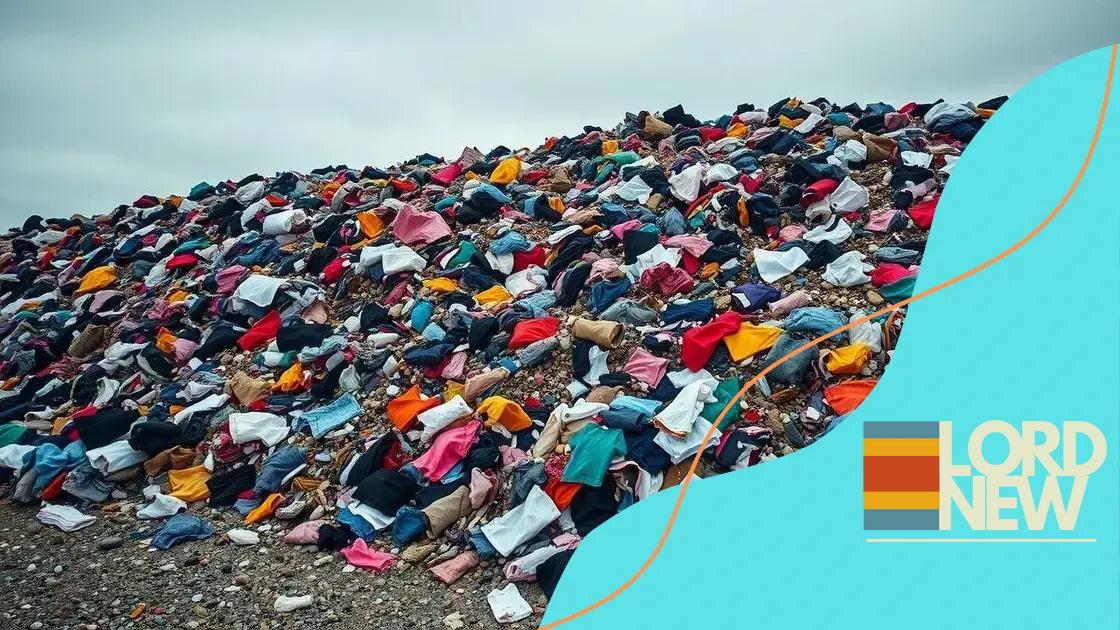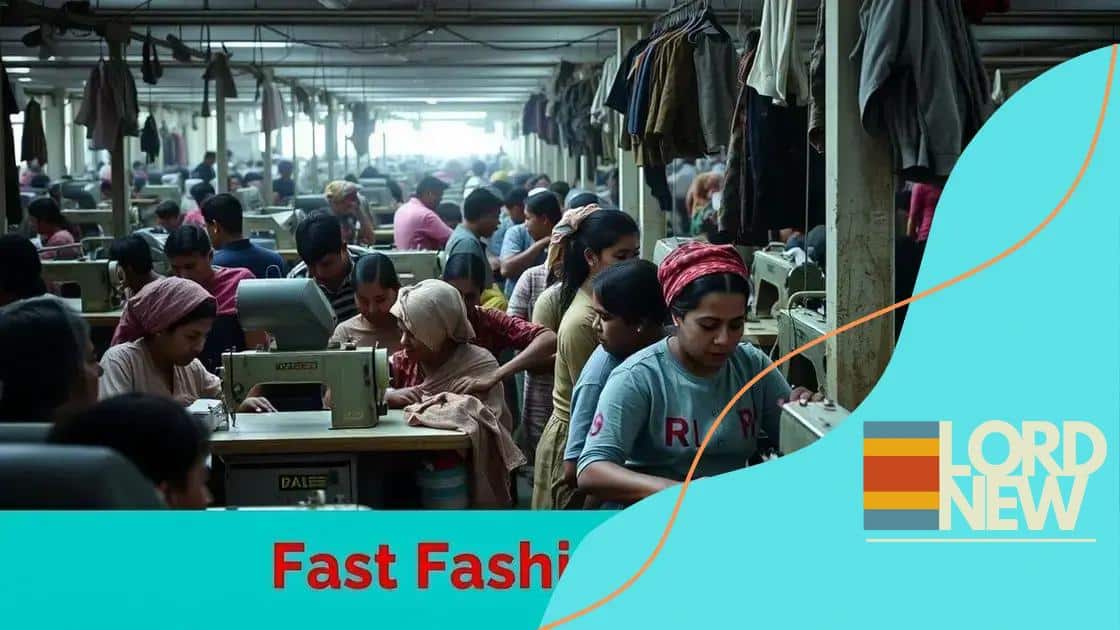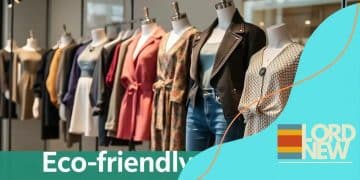Educational content on fast fashion’s environmental impact

Fast fashion significantly harms the environment and society through excessive waste, pollution, and exploitation of workers, making sustainable alternatives crucial for responsible consumer choices.
Educational content on fast fashion’s environmental impact is crucial for understanding our role in sustainability. Have you ever wondered how your clothing choices affect the planet? Let’s dive into this pressing issue.
Understanding fast fashion and its rise
Understanding fast fashion is vital in today’s world where our shopping habits have changed drastically. Fast fashion refers to inexpensive clothing that is quickly produced to keep up with the latest trends. Have you ever wondered how these trends affect our planet and society?
One of the main reasons fast fashion has risen so quickly is due to consumer demand. Many people want new clothes frequently, leading brands to create clothing lines that change every season. This cycle promotes a culture of disposability.
Key factors contributing to the rise of fast fashion
Several elements play a significant role in the growth of the fast fashion industry:
- The rapid production cycle allows brands to respond quickly to trends.
- Low prices make it easy for consumers to buy more items.
- Social media influences purchasing decisions, showcasing influencers and celebrities in new outfits.
- Online shopping has increased accessibility for shoppers worldwide.
Fast fashion also produces significant environmental impacts. From pollution to waste accumulation, the consequences are alarming. The industry is responsible for a massive amount of water usage and waste generation. For example, did you know that producing just one t-shirt can use about 2,700 liters of water?
This rapid consumption and disposal of clothing highlight a need for awareness about sustainable practices. As consumers, we have the power to make choices that favor the environment. Choosing quality over quantity can support more sustainable brands.
Consumer responsibility in fast fashion
By understanding how fast fashion operates, we can become more conscious shoppers. It’s essential to evaluate our purchasing habits and consider their long-term effects. Supporting brands that prioritize sustainability and responsible production practices contributes to a healthier planet.
Environmental costs of fast fashion
The environmental costs of fast fashion are staggering and often overlooked by consumers. As clothing is produced rapidly to meet market demands, the consequences for the planet become significant. It’s essential to understand what these costs entail.
One of the most notable impacts is the excessive use of water. The fashion industry is responsible for about 20% of global wastewater. This is largely due to the large volumes of water used in textile production. For example, to make a single pair of jeans, it can take over 7,000 liters of water!
Types of environmental impacts
- Water pollution: Chemicals from dyeing processes often end up in rivers and streams, harming aquatic life.
- Waste production: Millions of tons of clothing are discarded each year, contributing to overflowing landfills.
- Carbon footprint: The fast fashion industry generates significant greenhouse gas emissions from production and transportation.
- Deforestation: The demand for raw materials leads to deforestation, impacting wildlife and biodiversity.
Beyond just the production phase, the lifecycle of fast fashion contributes to pollution. When clothes are thrown away, many decompose and release methane, a potent greenhouse gas. This waste illustrates how our buying habits directly impact the environment.
It’s also troubling that many manufacturers utilize processes that employ hazardous chemicals. These substances can leak into waterways, impacting both ecosystems and human health. Consumers who are unaware of these practices often choose fast fashion for its affordability without realizing the true costs.
Shifting towards sustainability
Recognizing the environmental costs of fast fashion encourages consumers to make informed decisions. Opting for sustainable brands that focus on eco-friendly production methods can help reduce our carbon footprint. Additionally, embracing thrift shopping or clothing swaps can lessen the demand for new products.
As awareness grows, it’s crucial that consumers advocate for change in the fashion industry. Every small choice can contribute to a larger movement toward sustainability. Supporting ethical brands and practices can lead to a positive impact on the planet, promoting a healthier future for all.
Social implications of fast fashion trends

The social implications of fast fashion trends are profound and often overlooked. As more consumers embrace quick, trendy clothing, the fabric of society is impacted in various ways. Understanding these effects helps us recognize our role as shoppers.
One major concern is the exploitation of workers. Many fast fashion brands rely on overseas manufacturing where labor laws are weak. Workers often face long hours, low pay, and unsafe working conditions. This system supports a cycle of poverty for vulnerable communities.
The impact on local economies
Fast fashion can disrupt local economies, particularly in developing countries. Large retailers can outcompete local artisans and small businesses, forcing them to close. This leads to a loss of cultural identity as unique styles are replaced by mass-produced items.
- Job loss: Local shops may shut down due to competition.
- Dependence on foreign markets: Economies become reliant on brands that choose profit over ethics.
- Loss of craftsmanship: Traditional skills and techniques are often forgotten.
These factors contribute to a more homogenized global culture, where personal expression becomes limited. The allure of fast fashion often clouds the importance of supporting local makers and diverse styles.
Additionally, fast fashion promotes a culture of disposability. Many consumers purchase clothing with little thought about longevity or value. This mindset leads to constant turnover of wardrobes, with items often discarded after just a few wears.
Consumer responsibility and awareness
As consumers, we have the power to change these practices through our choices. Being mindful of where we shop can make a difference. Supporting ethical brands that prioritize fair labor practices helps promote social responsibility in the fashion industry.
Moreover, creating awareness around these issues empowers others to consider the social implications of their purchases. By choosing to engage in sustainable practices, such as second-hand shopping or investing in quality pieces, we can contribute to a more equitable fashion landscape.
Sustainable alternatives to fast fashion
Exploring sustainable alternatives to fast fashion is essential for those who want to make a difference. As awareness of the negative effects of fast fashion grows, many consumers are seeking out options that are better for the planet. Fortunately, there are several choices available.
One appealing alternative is thrift shopping. Thrift stores offer a wide variety of unique items at lower prices, and purchasing second-hand helps reduce waste. When you buy from these stores, you are giving clothes a second life, which is both economical and environmentally friendly.
Eco-friendly clothing brands
Many brands are now focusing on sustainability. These companies prioritize ethical production processes, using organic materials or recycled fabrics. Some notable brands include:
- Patagonia: Known for its environmental activism and use of recycled materials.
- Eileen Fisher: Focuses on responsible sourcing and fair labor practices.
- Everlane: Transparent about their supply chain and pricing.
- Reformation: Combines trendy styles with eco-conscious practices.
By investing in clothes from sustainable brands, consumers are supporting responsible practices that prioritize the health of both people and the planet.
Another alternative is to focus on capsule wardrobes. A capsule wardrobe simplifies your clothing choices by featuring a small number of versatile pieces. When you prioritize quality over quantity, you can create stylish outfits without needing a large collection. This method not only saves money in the long run but also reduces clutter and waste.
Renting and swapping clothes
Renting clothing is becoming increasingly popular for occasions such as weddings or parties. Instead of buying an outfit that may only be worn once, renting allows you to wear something new without the commitment of ownership. Another fun option is clothing swaps with friends or community events. This promotes sharing and creativity in your wardrobe.
Engaging in these sustainable practices not only helps reduce the negative impacts of fast fashion but also encourages a more thoughtful approach to consumerism. By choosing alternatives that value ethics and the environment, you contribute to a shift toward a more sustainable fashion industry.
How consumers can make a difference
Understanding how consumers can make a difference in the fashion industry is essential for driving change. Every purchase we make has the potential to impact the environment and society. By being mindful of our shopping habits, we can challenge the status quo.
One of the most effective ways to make a difference is to choose sustainable brands. Look for companies that prioritize ethical practices, such as fair labor conditions and environmentally friendly materials. This simple step encourages brands to adopt better practices.
The power of conscious shopping
Conscious shopping means making informed choices that reflect your values. Here are some strategies to help you:
- Research brands: Learn about the companies behind your favorite clothes. Check their practices and values.
- Support local businesses: Buy from local artisans and shops to boost your community’s economy.
- Choose quality over quantity: Invest in well-made pieces that will last longer, reducing the need for frequent replacement.
- Reduce, reuse, recycle: Donate or sell clothes you no longer wear instead of throwing them away. Recycle fabrics when possible.
Additionally, sharing information about sustainable practices can inspire others to change their habits. Social media platforms offer a unique space to educate friends and family about the effects of fast fashion. When you share your journey towards sustainability, it creates a ripple effect that encourages others to follow suit.
Participating in initiatives
Joining local sustainability initiatives or campaigns can amplify your impact. Many communities have organizations focused on environmental protection and sustainable fashion. Volunteering your time or participating in events, like clothing swaps or clean-up drives, fosters a sense of community and collaboration toward a common goal.
Moreover, educating yourself about the environmental impacts of fast fashion equips you to make better decisions. Read books, attend workshops, or follow thought leaders in the sustainability space to expand your understanding. Knowledge is power when it comes to affecting change in the industry.
By embracing these practices, you empower yourself and others to move away from fast fashion and its negative effects. Every small action counts toward creating a more sustainable future.
In conclusion, the journey towards understanding the environmental and social impacts of fast fashion reveals the power of consumer choice. By embracing sustainable practices, we can positively influence the fashion industry. Simple actions, like opting for ethically made clothing and supporting local businesses, contribute to a healthier planet and community. Together, we can create a more sustainable future for fashion, making a meaningful difference for ourselves and generations to come.
FAQ – Frequently Asked Questions about Fast Fashion and Sustainability
What is fast fashion?
Fast fashion refers to inexpensive clothing produced rapidly to keep up with the latest trends, often at the expense of quality and ethical practices.
Why is fast fashion harmful to the environment?
Fast fashion contributes to pollution, excessive waste, and overuse of resources, with significant negative impacts on water, land, and ecosystems.
How can consumers support sustainable fashion?
Consumers can support sustainable fashion by choosing eco-friendly brands, shopping second-hand, and reducing their consumption by opting for quality over quantity.
What are some alternatives to fast fashion?
Alternatives to fast fashion include thrift shopping, renting clothes for special occasions, creating a capsule wardrobe, and supporting local artisans.





